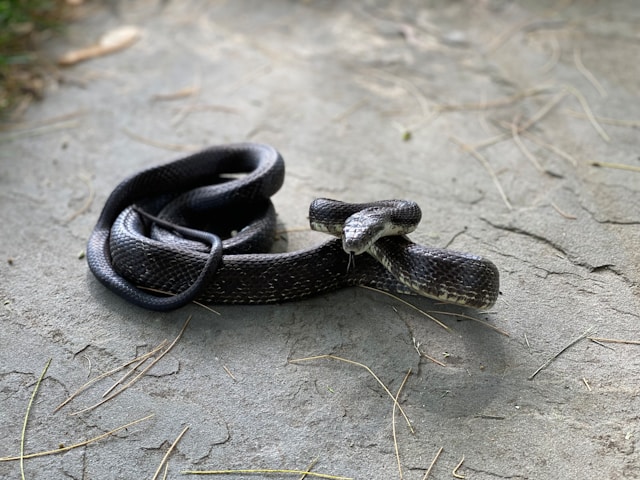
Interesting Wildlife Facts About Snakes
- Snakes are legless reptiles that are found in nearly every part of the world, except for Antarctica.
- They are carnivorous, feeding on a wide range of prey including rodents, birds, and insects.
- Snakes use their forked tongues to detect scents and track prey through a behavior known as “tongue flicking,” which helps them process scent particles via the Jacobson’s organ (vomeronasal system).
- While most snakes are non-venomous, venomous species use their toxins not only to immobilize or kill prey but also for defense.
- Snakes shed their skin periodically to allow for growth and to remove parasites.
Nuisance Issues with Snakes
- Property Damage: Snakes do not cause physical property damage, but their presence can cause psychological distress, especially in homes with young children or pets, though this risk is higher with venomous species.
- Venomous Bites: Some snakes, particularly venomous species, pose a direct threat to humans and pets through bites.
- Increased Pest Activity: Snakes help control pest populations, and their presence may signal an existing rodent issue rather than increasing pest activity.
- Fear and Anxiety: The sight of a snake can cause fear and anxiety, even if the snake is non-venomous or harmless.
Snake Behavior
- Solitary Creatures: Most snakes are solitary, with the exception of certain species that may form groups during hibernation or mating seasons.
- Hunting Techniques: Snakes use various methods to hunt, including constriction or injecting venom to subdue prey.
- Heat Detection: Many snake species, such as pit vipers, can detect heat through specialized pits located on their face, allowing them to hunt warm-blooded prey.
- Hibernate in Winter: In colder climates, snakes often enter a state of brumation (similar to hibernation) during the winter months.
Snakes and Diseases
- Salmonella: Snakes, particularly those kept as pets, can carry Salmonella bacteria, which can be transmitted to humans through contact with their skin or environment.
- Mites and Parasites: Snakes can harbor external parasites such as mites and ticks, which may be spread to humans or other animals.
- Snake Fungal Disease: Snake Fungal Disease (SFD), caused by Ophidiomyces ophidiicola, can lead to lesions, behavioral changes, and mortality in wild snake populations, weakening them and making them more susceptible to other infections.
Where in the US Are Snakes Found?
- Geographic Distribution: Snakes are found across the entire United States, with specific species inhabiting forests, grasslands, deserts, and wetlands.
- Preferred Habitats: Different species prefer various habitats, from woodlands and grasslands to urban and suburban environments.
- Common in Suburban Areas: Many snakes, including non-venomous varieties, are often found in suburban backyards where food sources like rodents are abundant.
Protecting Your Property from Snakes
To protect your property from snakes, start by sealing any potential entry points, such as gaps around doors, windows, and vents. Keep your yard clean by cutting back tall grass, trimming bushes, and removing piles of rocks, wood, or debris where snakes may hide. Installing snake-proof fencing, buried at least 6–12 inches underground with mesh no larger than 1/4 inch, can effectively prevent snakes from entering your property. Additionally, eliminating rodent populations around your property will reduce the food supply that attracts snakes. If you encounter a snake, contact a professional wildlife removal service for safe removal and relocation.
